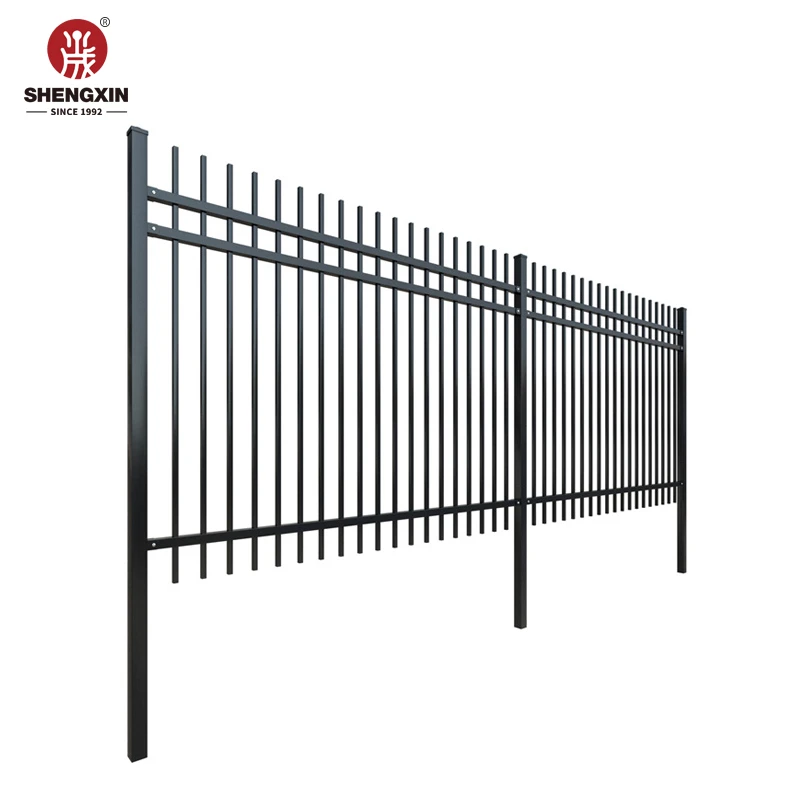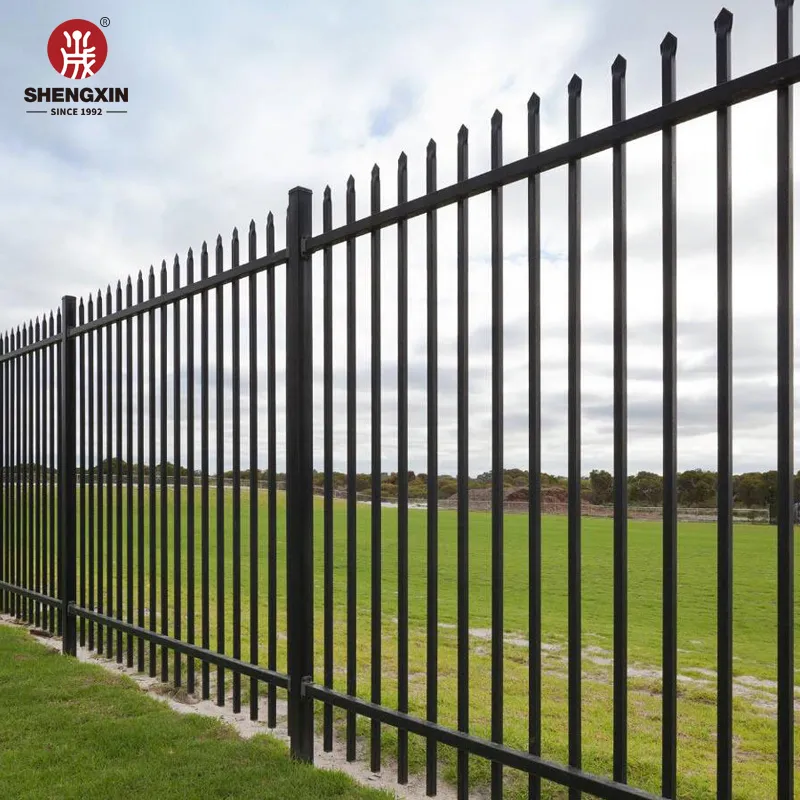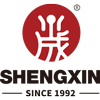
Jul . 08, 2025 07:33 Back to list
High-Quality Metal Picket Fence - Durable, Stylish & Customizable Solutions
- Introduction to Metal Picket Fence: Durability, Security, and Style Combined
- Technical Advantages and Material Strength of Metal Picket Fence
- Comparing Leading Metal Picket Fence Suppliers and Factories
- Customizable Solutions: Meeting Diverse Project Requirements
- Data-Driven Applications: Real-World Case Studies
- Maintenance, Longevity, and Future Trends
- Final Insights: Why Choose Metal Picket Fence for Modern Projects

(metal picket fence)
Introduction to Metal Picket Fence: Durability, Security, and Style Combined
Metal picket fences have become synonymous with security and elegance in residential, commercial, and industrial boundaries. Marrying durability with aesthetic appeal, these fences stand the test of time and harsh environmental conditions while providing a distinguished appearance. The global market for fencing, valued at over $30 billion in 2023, is projected to grow at a CAGR of 5.1% through 2028, with the metal segment capturing 38% share. High-tensile steel, corrosion-resistant coatings, and modular construction techniques distinguish the modern metal picket fence
from traditional wooden or vinyl barriers. End-users increasingly recognize the advantages: improved perimeter security, minimal maintenance costs, and resistance to pests and fire.
Technical Advantages and Material Strength of Metal Picket Fence
The evolution of metal picket fence manufacturing has ushered in an era defined by advanced metallurgy and precision fabrication. Today’s leading products leverage galvanized steel, powder-coated aluminum, and zinc alloys to ensure robust protection and longevity. For instance, powder-coated steel can withstand up to 3,500 hours of salt spray testing, outperforming painted options by over 70%. Such treatments provide triple-layer defense against rust, UV fading, and scratch damage. Designs have shifted towards modular interlocking panels, which enhance rigidity and streamline installation—cutting labor time by up to 40% compared to manual assembly.
Upright pickets, available in widths from 16mm to 25mm, support various anti-climb and decorative finial options. Moreover, double-welded horizontal rails increase impact resistance by up to 30%. This technical prowess ensures that metal picket fences are not only visually appealing but also engineered for high-security applications such as airports, public parks, and premium residential estates.
Comparing Leading Metal Picket Fence Suppliers and Factories
Selecting the right supplier or factory is crucial for achieving the desired balance of price, quality, and customization. Manufacturers differ in aspects such as capacity, ISO certification, advanced coating lines, and lead times. Below is a data-driven comparison highlighting three prominent suppliers:
| Supplier/Factory | Annual Output (tons) |
Production Lead Time | ISO Certification | Minimum Order (meters) | Custom Design Support | Export Markets |
|---|---|---|---|---|---|---|
| Alpha Metal Works | 7,500 | 14–21 days | 9001:2015 | 50 | Yes | US, EU, AU |
| Securite Metal Fencing | 12,000 | 10–15 days | 9001:2015 & 14001:2015 | 100 | Yes | Global |
| UrbanGuard Fences | 9,500 | 15–20 days | 9001:2015 | 80 | Yes | EU, SA, ME |
The comparison illustrates distinctions in capacity and international compliance, along with the availability of bespoke services. Leading factories invest in automated welding lines and inspection equipment, ensuring product consistency and faster turnaround for metal picket fence quotes and shipments globally.
Customizable Solutions: Meeting Diverse Project Requirements
Flexibility is at the core of modern metal picket fence manufacturing. Customization options are extensive, with factories offering tailored heights (900mm–2400mm), various powder coat colors per the RAL chart, and adaptability to sloped terrain or architectural features. For government, commercial, and heritage projects, CAD-based design services enable precise alignment with client concepts and lifecycle cost analysis.
Special requests—such as integrated access gates, anti-intruder spikes, or ornamental flourishes—can be factored in at the production stage, with some suppliers even providing (EN 10244-2 or ASTM A123/A123M compliant) galvanizing for harsher climates. Such attention to project-specific needs not only enhances security and aesthetics but can also improve property valuations by 2–3% upon the installation of high-grade fencing.
Data-Driven Applications: Real-World Case Studies
The versatility of metal picket fences is demonstrated through a variety of high-profile installations. In one major North American urban renewal initiative, over 17,000 meters of powder-coated steel fence were installed in school perimeters, reducing unauthorized access incidents by 42% within the first year. In Australia, a municipal park upgrade leveraged aluminum picket fences to comply with local corrosion resilience standards, extending expected lifecycle to over 25 years with only bi-annual maintenance.
Industrial users have adopted high-security picket fencing in logistics centers, where double-rail designs and electronic access controls deliver a 60% decrease in on-site theft. The data underscores both the preventive and value-enhancing benefits of choosing a well-engineered metal picket fence.
Maintenance, Longevity, and Future Trends
Cost-efficiency over time is a defining factor for property owners and managers. Metal picket fences require minimal upkeep—typically restricted to periodic cleaning and visual inspection. Powder-coated and galvanized variants report 10–15 years with no need for repainting, in contrast to the 3–5 year cycle for wooden installations. Innovations on the horizon include solar-powered lighting integrated into pickets, smart-lock gates, and nano-ceramic coatings, promising even greater anti-corrosion performance.
According to the 2023 Fence Industry Outlook report, demand for smart fencing solutions is expected to climb by 12% annually, with eco-friendly materials and automated manufacturing reshaping supplier strategies and product offerings.
Final Insights: Why Choose Metal Picket Fence for Modern Projects
Choosing a metal picket fence for your property or project delivers a powerful combination of security, durability, and visual appeal. Backed by technically advanced production, a wide array of customizable options, and data-supported performance metrics, this type of fencing solution responds to the evolving needs of contemporary asset owners. Whether sourced directly from a reputable metal picket fence factory or through authorized suppliers, transparency in quotes, certification, and after-sales support remains essential. The future of perimeter protection is unmistakably metal, driven by innovation and proven by real-world results.

(metal picket fence)
FAQS on metal picket fence
Q: What is a metal picket fence?
A: A metal picket fence is a decorative and durable barrier made from steel or aluminum. It’s commonly used for property boundaries and security. These fences feature vertical metal pickets with spacing in between.Q: How can I get quotes for a metal picket fence?
A: You can request metal picket fence quotes directly from manufacturers or suppliers online. Provide your dimensions and design preferences for accurate pricing. Most companies respond within 24-48 hours.Q: What should I consider when choosing a metal picket fence factory?
A: Look for a metal picket fence factory with a good reputation, certifications, and customizable options. It’s also important to check their production capacity and lead times. Reviews and sample quality are reliable indicators.Q: Are there reliable metal picket fence suppliers for bulk orders?
A: Yes, many metal picket fence suppliers specialize in bulk orders for residential, commercial, and industrial projects. They often offer discounts for large quantities. Ask for samples before finalizing your purchase.Q: What maintenance is required for a metal picket fence?
A: Metal picket fences are low maintenance but should be inspected regularly for rust or damage. Cleaning them with mild detergent and water helps prolong their life. Applying protective coatings can prevent corrosion.This is the last article
-
High-Quality Metal Picket Fence - Durable, Stylish & Customizable Solutions
NewsJul.08,2025
-
358 Anti-Climb Fence High Security Mesh, Durable & Cost-Effective Solutions
NewsJul.08,2025
-
High-Quality Chain Link Fence Parts Reliable Suppliers & Factory Prices
NewsJul.07,2025
-
Clear View Fence Anti Climb - High Security Fencing Factory & Suppliers Quotes
NewsJul.07,2025
-
Temporary Fence Business for Sale Factory Direct Suppliers & Best Quotes
NewsJul.06,2025
-
High-Quality Temporary Fence Fittings - Trusted Factory & Suppliers Get Quick Quotes
NewsJul.06,2025
